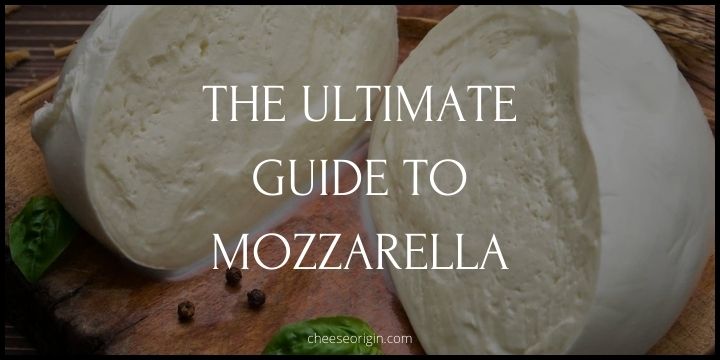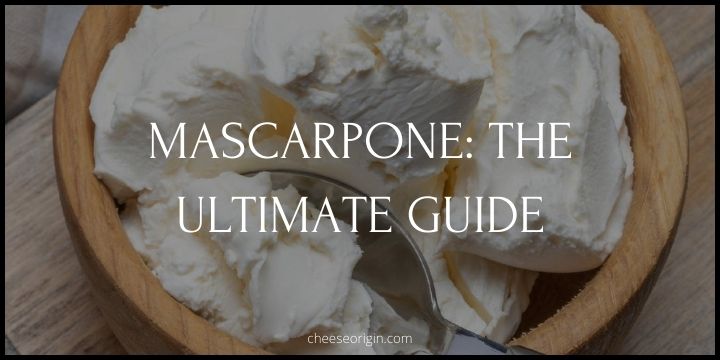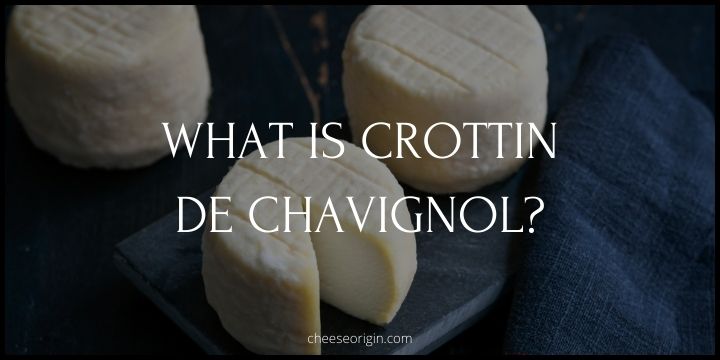What is Stilton? The King of English Blue Cheese

Derived from the quaint village of Stilton in England, this blue-veined beauty has held its royal status in the world of cheeses for centuries. Each crumble tells a story, and each bite is an adventure.
Whether you’re a seasoned gourmand or a curious foodie, this guide will deepen your appreciation of this culinary gem and leave you with an insatiable longing for more.
So, brace yourself for an epicurean ride as we delve into the world of Blue Stilton, a cheese that truly deserves its crown.
From its origins and production process to pairing suggestions and storage tips, consider this your ultimate resource for all things Stilton. Let’s unravel the mystery behind this majestic cheese together.
Also read: Top 10 Most Popular England Cheeses
Quick facts about Stilton cheese
| Quick Facts | Stilton Cheese |
|---|---|
| Origin | England |
| Region | Leicestershire, Derbyshire, and Nottinghamshire |
| Type | Semi-soft, blue-veined cheese |
| Made from | Cow’s milk |
| Pasteurized | Yes |
| Rind | Natural, edible |
| Ageing time | 9 weeks minimum |
| Certification | Protected Designation of Origin (PDO) since 1996 |
| Color | White, with distinctive blue veins |
| Flavor | Rich and creamy with a spicy tang |
| Aroma | Strong, pungent |
| Texture | Crumbly yet smooth and slightly buttery |
| Fat content | 35% |
| Pairings | Port wine, walnuts, honey, fresh pears and apples |
| Known as | “The King of English Cheeses” |
What is Stilton cheese?

Stilton cheese is a type of English cheese that is known for its distinctive blue veins and strong, unique flavor. It’s often referred to as the “King of English Cheeses”. This semi-soft cheese is made from pasteurized cow’s milk and has a rich, creamy texture with a spicy tang.
Stilton is produced in two varieties: Blue Stilton and White Stilton. Blue Stilton is aged for a minimum of nine weeks and has a crumbly yet smooth texture and a pungent aroma. It’s recognized by its series of blue veins spiraling out from the center and has a stronger flavor than White Stilton.
White Stilton, on the other hand, is a younger, milder cheese that does not contain the Penicillium roqueforti mold that gives Blue Stilton its characteristic veining and flavor. It’s often blended with fruits or nuts.
The production of Stilton is geographically protected; it can only be made in the three counties of Derbyshire, Nottinghamshire, and Leicestershire in England. The cheese gets its name from the village of Stilton, where it was originally sold.
Stilton is popular in cooking and pairs well with a variety of foods, including pears, apples, and walnuts. It’s also traditionally served with Port wine.
What does Stilton taste like?
Stilton cheese offers a unique flavor profile that is highly prized among cheese connoisseurs. The taste can vary somewhat depending on its age, but generally, Stilton boasts a rich and creamy texture that carries a sharp, slightly tangy flavor with a hint of sweetness.
Blue Stilton, which is the more common variety, has a robust and pungent taste due to its blue veins created by the Penicillium roqueforti mold. It features a complex blend of flavors – it’s earthy and nutty with a spicy aftertaste that lingers pleasantly on the palate.
White Stilton, on the other hand, is milder and creamier. It does not contain the blue veins of its counterpart, resulting in a subtler flavor. It’s often combined with various fruits or nuts to complement its delicate taste.
Despite their differences, both Blue and White Stilton have an unmistakable melt-in-your-mouth texture that adds to their appeal. Whether enjoyed as part of a cheese board, crumbled over salads, or used in cooking, Stilton cheese delivers a gourmet experience that is sure to delight your taste buds.
Stilton tasting notes
- Appearance: Stilton cheese is characterized by its distinct blue-green veining spreading out from the center against a creamy, ivory-colored base. It’s typically cylindrical in shape with a natural, edible rind.
- Texture: Stilton has a crumbly yet buttery texture. It’s semi-soft and melts in the mouth due to its high butterfat content.
- Smell: The aroma of Stilton is strong and pungent, which can be attributed to the Penicillium roqueforti mold used in its production.
- Taste: The flavor of Stilton is robust and complex. It’s rich and creamy with a sharp, slightly tangy taste. There’s a hint of sweetness that balances out the spicy notes. The aftertaste is lingering and pleasantly spicy.
- Blue Stilton: This variety is known for its bold, earthy and nutty flavor profile. The blue veins contribute to its intense taste and pungency.
- White Stilton: This variety is milder and creamier than Blue Stilton. It doesn’t contain the blue veins, leading to a subtler flavor. It’s often combined with fruits or nuts to enhance its delicate taste.
- Pairings: Stilton pairs well with a variety of foods and drinks. Traditional pairings include Port wine, walnuts, fresh pears, and apples. It also goes well with robust red wines, dark beers, and sweet sherry.
Also read: What Fruit Goes on a Charcuterie Board?
What is the difference between blue cheese and Stilton?
Blue cheese and Stilton are both types of blue-veined cheeses, but they have several key differences in terms of their origin, production process, and flavor profile:
| Blue Cheese | Stilton | |
|---|---|---|
| Origin | Made in various parts of the world. | Made only in Derbyshire, Nottinghamshire and Leicestershire, England. |
| Type of Milk | Can be made from cow, sheep, or goat’s milk. | Made only from pasteurized cow’s milk. |
| Production Process | Cultures of the mold Penicillium are added, creating blue veins. | The crust of the cheese is pierced with needles during aging to stimulate the growth of the Penicillium roqueforti mold, creating distinctive blue veins. |
| Protection Status | Some types have PDO or PGI status depending on their region of origin. | Has EU Protected Designation of Origin (PDO) status and is protected by a Certification Trade Mark. |
| Flavor Profile | Flavor can vary widely, but generally has a sharp, pungent flavor and a salty bite. Some types can be quite strong and spicy, while others are creamier and milder. | Rich and creamy texture with a complex flavor that is sharp, slightly tangy, and sweet. The blue veins give it a distinct spicy aftertaste. Compared to some other blue cheeses, Stilton tends to have a more balanced and less aggressive flavor. |
Origin and Production:
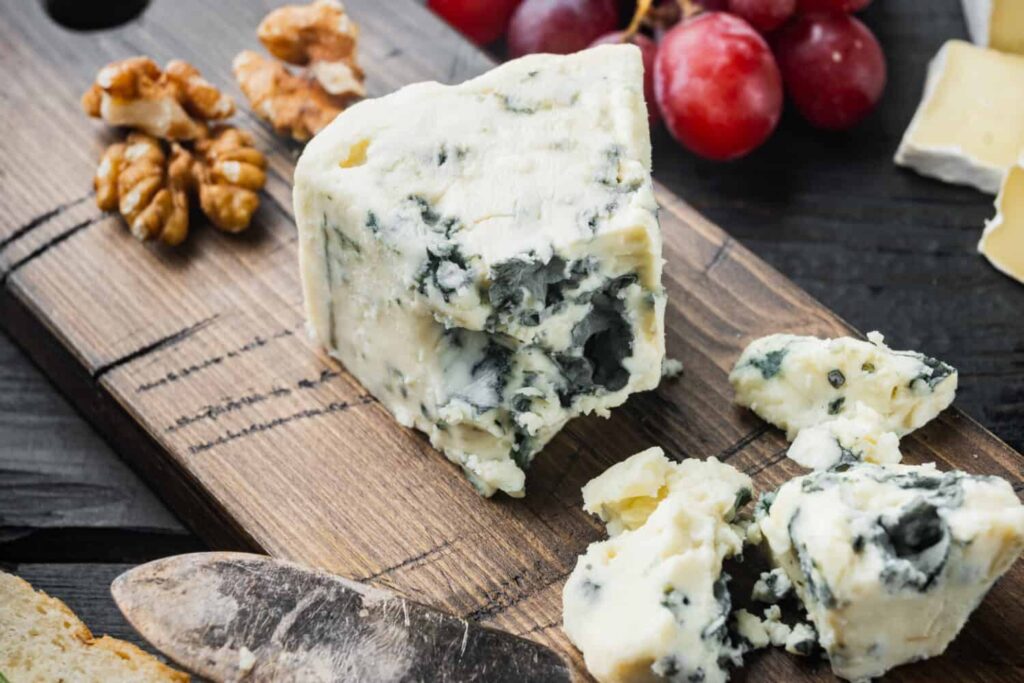
Blue Cheese:
This is a general term for cheeses that have had cultures of the mold Penicillium added to them, resulting in spots or veins of blue, blue-gray or blue-green mold throughout the cheese. Blue cheese can be made from cow, sheep, or goat’s milk, and it can be produced in many parts of the world. Examples include Roquefort from France, Gorgonzola from Italy, and Danish Blue from Denmark.
Stilton:
Stilton is a specific type of blue cheese that is protected by a Certification Trade Mark and EU Protected Designation of Origin (PDO) status, meaning it can only be produced in the three counties of Derbyshire, Nottinghamshire, and Leicestershire in England. It’s made from pasteurized cow’s milk and has distinctive blue veins which are created by piercing the crust of the cheese with stainless steel needles during the aging process to let in air that stimulates the growth of the Penicillium roqueforti mold.
Flavor Profile:

Blue Cheese:
The flavor of blue cheese can vary widely depending on the specific type and age of the cheese. In general, blue cheeses tend to have a sharp, pungent flavor and a salty bite. Some can be quite strong and spicy, while others are creamier and milder.
Stilton:
Stilton has a rich, creamy texture with a complex flavor that is sharp and slightly tangy, but also has a hint of sweetness. The blue veins give it a distinct spicy aftertaste. Compared to some other blue cheeses, Stilton tends to have a more balanced and less aggressive flavor.
Also read: The Art of Blue Vein Cheese: A Journey Through Flavor and Texture
Why does Stilton taste so good?
The exceptional taste of Stilton cheese can be attributed to several factors:
- Quality Ingredients: Stilton is made from high-quality, locally sourced, pasteurized cow’s milk. The quality of the milk plays a significant role in the final flavor of the cheese.
- Traditional Techniques: The production process of Stilton involves traditional cheese-making techniques that have been perfected over centuries. This includes careful curdling, draining, molding, and aging processes that contribute to its unique flavor.
- Blue Veining: The distinctive blue veins in Stilton are a result of the Penicillium roqueforti mold. The cheese is pierced with stainless steel needles during the aging process to allow air to enter and stimulate the growth of this mold. This gives Stilton its characteristic strong, pungent flavor and spicy aftertaste.
- Balanced Flavor Profile: Stilton has a complex flavor profile that’s rich, creamy, and slightly tangy, with a hint of sweetness. This balanced combination of flavors appeals to many palates, making it a favorite among cheese connoisseurs.
- Aging Process: The aging process also contributes significantly to the flavor of Stilton. As it ages, the cheese develops a fuller, deeper flavor and a crumbly yet creamy texture.
- Protected Designation of Origin (PDO) Status: Stilton’s PDO status ensures that only cheese produced in the three counties of Derbyshire, Nottinghamshire, and Leicestershire, and according to strict guidelines, can be called Stilton. This maintains the quality and distinctive taste of the cheese.
What is the best way to eat Stilton cheese? This is how to eat Stilton:
- At Room Temperature: Like most cheeses, Stilton should be served at room temperature to fully appreciate its complex flavors.
- On a Cheese Board: Stilton makes an excellent addition to any cheese board. Pair it with fresh fruits like apples, pears, and figs, or dried fruits like dates and apricots. Add some crunchy nuts like walnuts or almonds for contrast.
- With Wine or Port: Traditionally, Stilton is often paired with a glass of Port or a full-bodied red wine. The sweetness of the wine complements the tangy, savory flavor of the cheese.
- In Cooking: Crumble or melt Stilton into soups, salads, pasta dishes, or steaks for a burst of rich flavor. It also pairs well with caramelized onions or mushrooms.
- On Crackers or Bread: Spread a generous amount of Stilton on a cracker or a slice of crusty bread. You could add a drizzle of honey or a dollop of chutney for an extra layer of flavor.
- With Desserts: Believe it or not, Stilton pairs wonderfully with certain desserts. Try it with dark chocolate or incorporate it into a cheesecake recipe for a unique twist.
Note: Stilton is a strong and flavorful cheese, a little goes a long way. Enjoy!
Also read: 11 Best Crackers that Pair Well with Cheese
Is Stilton a healthy cheese?
Stilton, like many other cheeses, can indeed be part of a healthy diet when consumed in moderation.
- Rich in Nutrients: Stilton is a good source of protein, calcium, and phosphorus. It also contains vitamins A and B2 (riboflavin).
- Contains Vitamin K2: Stilton is known to contain Vitamin K2, a fat-soluble vitamin that has been associated with some potentially significant health benefits, such as supporting bone and heart health.
- Beneficial Bacteria: The blue veins in Stilton are a type of mold that can contribute to the balance of bacteria in your gut, which is essential for overall health.
- Low in Calories: Compared to some other types of cheese, Stilton is relatively low in calories, making it a better choice for those watching their caloric intake.
Stilton nutrition facts
| Nutrition Facts | Amount per 1 oz (28g) |
|---|---|
| Calories | 110 kcal |
| Carbohydrates | 1.0 g |
| Fat | 10.0 g |
| Protein | 7.0 g |
| Sodium | 220 mg |
| Vitamin A | 150µg (19% of RDA/RI) |
| Phosphorus | 125.6mg (18% of RDA/RI) |
| Calcium | 92.12 mg |
| Potassium | 26.88 mg |
Is Stilton cheese expensive?

Yes, certain types of Stilton cheese can be quite expensive. Particularly, the White Stilton Gold is considered one of the most expensive cheeses in the world.
It’s a limited edition cheese produced by Long Clawson Dairy in Leicestershire, England. This cheese is unique because it’s encased in a layer of edible gold leaf, contributing to its high price. The cost can range from $355 to $500 per pound.
However, it’s important to note that regular Stilton blue cheese, while still considered a premium cheese, is not nearly as expensive as its golden cousin.
The price for regular Stilton will vary depending on where you buy it and the specific brand.
The price of regular Stilton on online retailers:
- Gouda Cheese Shop offers Stilton at a regular price of €215.60 (approximately $253.00), currently on sale for €194.05 (approximately $227.50).
- Wisconsin Cheese Mart sells Stilton starting from $10.00.
- Amazon lists a half wheel of Stilton (5lbs) with a price per unit of $4.12 per ounce, which amounts to approximately $330 for the whole half wheel.
- Another listing on Amazon, the Royal Blue Stilton DOP Cheese by Long Clawson, is priced at $27.50 per count.
- iGourmet offers Long Clawson Royal Blue Stilton DOP Cheese at prices ranging from $14.49 for 7.5 oz to $56.99 for a 2.5 lbs half moon cut.
- Honey and Harp sells Blue Stilton – Long Clawson Royal Blue DOP Cheese (7.5oz) at a regular price of $18.00.
- Lee’s Gourmet Direct offers a wedge of Blue Stilton Cheese (8 ounces) for $11.99 and a pound for $22.99.
- The Cheese Gallery lists Clawson or Stevenson Stilton (blue – cow) at a regular price of $15.00.
- White Horse Wine & Spirits sells Stilton Blue at a regular price of $13.00.
Note: that these prices can vary over time and may not include potential shipping costs.
7 best Stilton substitutes
| Substitute | Description |
|---|---|
| Gorgonzola | Gorgonzola is an Italian blue cheese that shares a similar tangy flavor with Stilton. It’s slightly creamier and can be used in both cooking and as a table cheese. |
| Roquefort | This French cheese is made from sheep’s milk and offers a strong, tangy flavor similar to Stilton but has a creamier consistency. It’s a suitable substitute in many recipes. |
| Fourme D’Ambert | Fourme D’Ambert is a milder French blue cheese with a creamy texture. It’s an excellent choice if you want a less potent flavor but still desire the distinctive blue cheese character. |
| Bleu D’Auvergne Cheese | This is another French blue cheese. It’s less salty than Stilton but still provides a comparable punch of flavor. |
| Feta Cheese | While not a blue cheese, feta’s tangy and salty flavor can make it a good substitute for Stilton in some recipes. |
| Danish Blue | Also known as Danablu, this cheese is semi-soft and blue-veined, with a milder and creamier taste than Stilton. It’s a good option if you prefer a less intense flavor. |
| Dorblu Cheese | Dorblu is a German blue cheese that offers a creamy texture and a slightly spicy flavor. It can be a good option for those who want cheese with a bit more bite. |
What pairs well with Stilton?

Food that goes well with Stilton
| Category | Food |
|---|---|
| Breads and Crackers | Plum bread, Oatcakes |
| Fruits | Apples, Grapes, Dried fruits, Pears, Figs |
| Vegetables | Winter vegetables, Celery (in soup), Leeks (in tartine), Mushrooms (in tartine), Roasted apples in pithivier |
| Condiments | Mango chutney, Honey |
| Dairy and Others | Gnocchi (blue cheese gnocchi), Ham (in tart), Beef (blue cheese pairings with beef) |
| Nuts | Walnuts |
Also read: What Fruit Goes on a Charcuterie Board?
Beverage that goes well with Stilton
| Category | Beverage |
|---|---|
| Wine | Sauternes, Tokaji, Aged Margaret River Cabernet Sauvignon, Tawny Port, White Port, Malbec, Prosecco, Madeira, Chardonnay |
| Gin | Sloe gin |
| Sherry | Sweet sherry |
| Whiskey | Islay whiskey |
| Other | Barley wine, Vin Santo, Orange wine |
Also read: Best Wine and Cheese Pairings: The Ultimate Guide
The history and origin of Stilton cheese
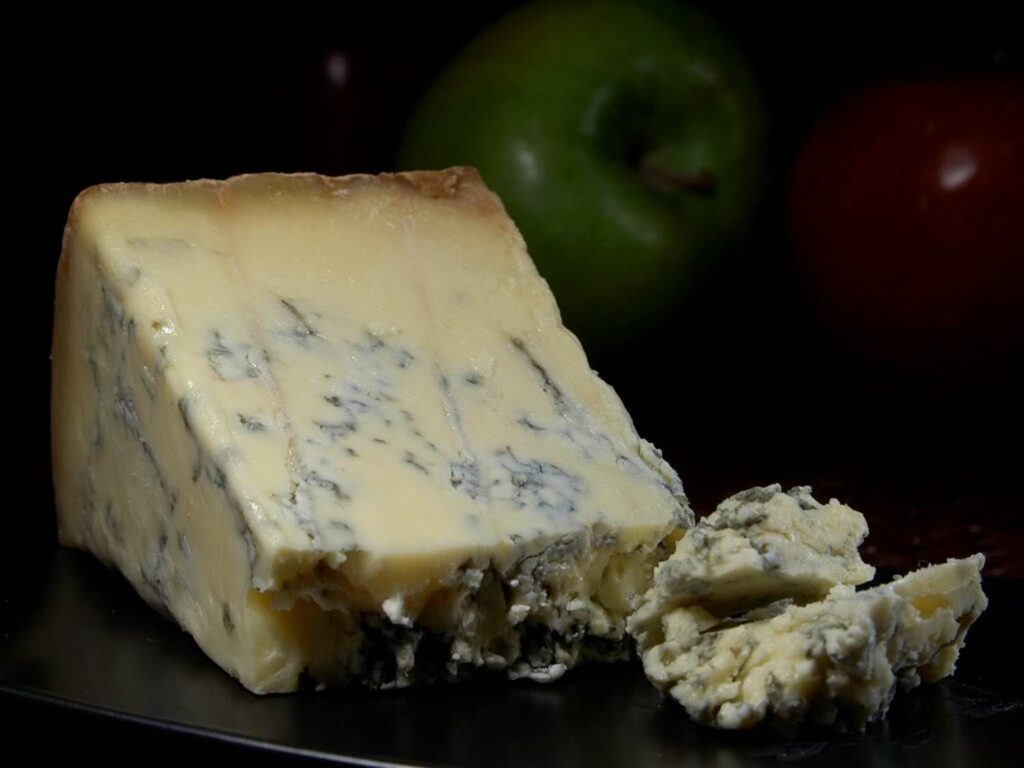
Stilton cheese, a classic English blue cheese, has a rich and storied history. While its name is derived from the village of Stilton in Huntingdonshire, it’s interesting to note that according to tradition, it was first sold in this village but not necessarily made there.
The origins of Stilton can be traced back to the early 18th century. The recipe used at that time has significantly changed over the years. It was The Bell Inn, located in Stilton, that played a key role in popularizing the cheese. This inn was a stopover point for people traveling North, thus making Stilton cheese widely known.
Two significant figures in the history of Stilton cheese are Cooper Thornhill and Frances Pawlett. They were responsible for the successful commercialization of Stilton Cheese and the development of a recipe that is the basis for the cheese we know today.
Despite the manufacture of cheese in Stilton continuing long after production took off in Leicestershire, there is evidence that it began to decline in quality over time.
Today, Stilton is a registered trademark by the Stilton Cheesemakers’ Association, which was founded in 1936. This trademark protects the cheese, ensuring its standard and quality.
Even though the cheese takes its name from a picturesque Cambridgeshire village, it is not made anywhere near the place. Certified Stilton cheeses can only be made in the counties of Derbyshire, Leicestershire, and Nottinghamshire.
Frequently Asked Questions
1. Can you eat the hard part of Stilton?
Yes, the rind of Stilton cheese is typically safe to eat. However, it might have a stronger and more intense flavor compared to the softer, creamier inside part of the cheese. Some people enjoy this added complexity in flavor, while others prefer to remove the rind. It’s really a matter of personal preference.
That said, the rind can sometimes be a bit tough or waxy due to the aging and maturation process that Stilton cheese goes through. If you find the texture unpleasant, you may want to discard it.
Lastly, if the rind appears moldy or excessively dried out, it’s best to err on the side of caution and not consume it. Always ensure your cheese is stored properly to maintain its quality and safety.
2. Is Stilton just Mouldy cheese?
Stilton is often referred to as a “blue cheese,” which means it contains a certain type of mold. However, that doesn’t mean it’s just a “moldy cheese” in the way one might think of a piece of forgotten cheddar turning fuzzy in the fridge.
Blue cheeses like Stilton are made by introducing specific strains of edible mold (Penicillium roqueforti or Penicillium glaucum) into the cheese during the production process. This mold is what gives blue cheese its distinctive veins or spots of blue, blue-gray or blue-green mold throughout the cheese.
The mold contributes to the cheese’s flavor and aroma, creating a product that’s tangy, pungent, and complex in taste. The process is carefully controlled and the molds used are safe for consumption.
So while Stilton does indeed contain mold, it’s very different from the unwanted, spontaneous mold growth you might find on other foods.
3. How to tell if my Stilton has gone bad?
- Unusual Smell: While Stilton cheese naturally has a strong, pungent smell due to the blue mold, an overly sour or unpleasant smell can be a sign that the cheese has gone bad.
- Discoloration: If you notice any pink, red, or brown hues on your blue cheese, it’s likely spoiled. These colors are signs of bacterial growth.
- Excessive Mold Growth: While Stilton is a type of blue cheese and does contain mold as part of its character, excessive mold growth or mold of a different color (like black, green, or white) could indicate that the cheese has spoiled.
- Change in Texture: If the cheese feels slimy, it’s a sign that it’s gone off. Fresh Stilton should feel crumbly.
- Taste: If you’re still unsure, you can taste a small piece. If it tastes sour or just off, it’s likely spoiled.
Remember to always store your Stilton cheese properly to extend its shelf life. It should be kept in the fridge, wrapped in waxed paper or foil, and stored in a container with a little bit of air circulation. If you have doubts about the safety of your cheese, it’s best not to risk it and throw it away.
Also read: What’s the Best Way to Store Cheese?
4. Is Stilton a raw cheese?
Stilton cheese is not made from raw milk, but from pasteurized milk. Traditionally, Stilton was made from raw milk, but changes in regulations during the 20th century led to the use of pasteurized milk instead.
The change occurred due to food safety concerns, particularly after an outbreak of listeria was thought to be linked to the use of raw milk in making Stilton, although the connection was never definitively proven.
However, there is a cheese similar to Stilton that is made with raw milk, called Stichelton. Stichelton is crafted in a similar manner to traditional Stilton, but because it uses raw milk, it cannot legally be called Stilton. The name “Stichelton” is the Old English name for the village of Stilton.
So, while Stilton cheese as we know it today is made from pasteurized milk, those looking for a raw milk version can seek out Stichelton.
Also read:
- Menonita Cheese: A Staple in Northern Mexican Cuisine
- Discover Fontina: An In-depth Guide to Valle d’Aosta’s Culinary Pride
- The Ultimate Guide to Bocconcini: From Origin to Plate
- The Ultimate Guide to Muenster Cheese: Savor the Flavor
- The Ultimate Guide to Monterey Jack: History, Uses and Pairings
- The Ultimate Guide to Chèvre: Exploring Goat Cheese
- The Ultimate Guide to Kasseri: A Taste of Tradition
